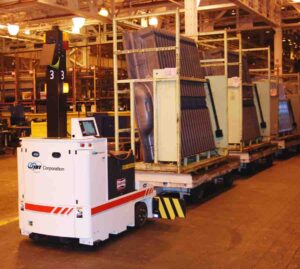Automated Guided Vehicle (AGV)
Automated guided vehicles (sometimes called Automatic Guided Vehicles) are driverless vehicles that primarily perform transportation functions. In most cases, they support materials groups in distribution of raw materials and in movement of finished goods. These vehicles may either operate similar to a pallet jack, and carry the load, or as a tow-truck, and pull the load. They are guided by a variety of means, including a buried wire with RF transmissions, magnetic tape, reflectors mounted throughout the facility, or even more sophisticated technologies that sense the environment or track motion. Increasingly advanced technologies are regularly added to AGVs, increasing their usefulness.


AGVs take a logical step in separating man from machine. This step, however, is fairly uncommon in most facilities. This is in large part because of the lack of standard work in the materials teams in most facilities. In a manufacturing environment, it is very commonplace for a person to place a part in a machine, press a button, and walk away as part of the prescribed sequence of tasks. Even in some office environments, there is a degree of separation of man and machine. People can put a stack of papers on a fax machine, press a button, and walk away. IT people can press a button to start the backup process. (Note that materials teams do tend to have standardization. It is just seldom to the level of predictable work linked to the pace of production.)
In materials, the process is most frequently a reactive one—a delivery arrives, the receiving team sorts the parts, and the material handler takes those parts to their areas of responsibility. Materials teams also frequently respond to calls about parts shortages. Because this is not a defined process, there is less opportunity to automate.
Some companies are taking the next step, however, and creating standard work for material handlers. This includes routes for replenishment, with a greater degree of standardization, and predictability. This presents the opportunity for AGVs. A receiving operation can load up an AGV, and send it out on its route, where material handlers unload raw materials at prescribed times, and load packaging materials (i.e. trash) and finished goods to return to the dock. Again, a precursor to being able to effectively use AGVs in material handling is the creation of standard work.
Another opportunity for AGVs is related to “virtual cells”. In some cases, a facility is constructed with flow in mind (greenfield construction). In many cases, a facility has a legacy of batch manufacturing but has been converted to flow to some degree. Unfortunately, the existing facility layout (brownfield) often has some constraints built in that limit flow. In these cases, an AGV can be used to link sequential processes, even if they are not located right next to each other. A kit of welded parts may be sent to a paint shop on an AGV. Because workers don’t need to be involved in the transport, this mimics some degree of flow without impacting productivity.

Even if you have no plan to use AGVs, consider the steps you would have to take to prepare to use them.
You would have to standardize processes, define roles, limit quantities, keep areas in order, mark locations, etc. All of those things should be done anyway. If you create an action plan to prepare for an AGV, you’ll see some tremendous gains in your material handling teams.
Try defining a route and use a manned cart. Have each material handler deliver the cart to the next location. Even if you never move past that step, you’ll still have some great structure added to your support processes, which means fewer disruptions to your production teams. It will also make the decision to purchase an AGV easier if you know exactly how it will be used and you can see an immediate reduction in work for the material handler team.


0 Comments